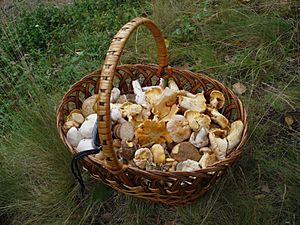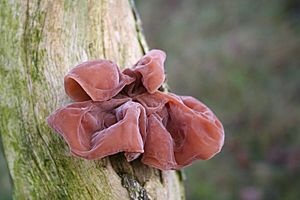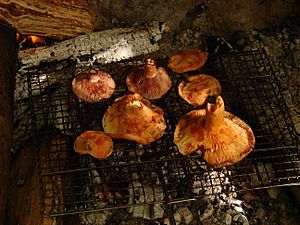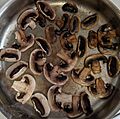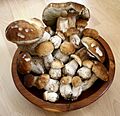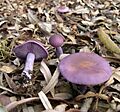Edible mushroom facts for kids
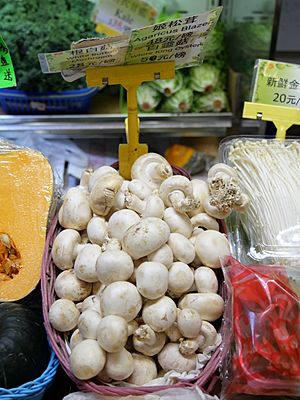
Edible mushrooms are the tasty, fleshy parts of certain fungi that we can eat. Think of them like the "fruit" of a fungus! Some grow underground, and some grow above ground where people can pick them. For a mushroom to be called "edible," it must be safe to eat, taste good, and smell nice. People eat mushrooms for their nutrition and because they add great flavor to food. Dried shiitake mushrooms, for example, are known for a special savory taste called umami. The very best and most wanted mushrooms are sometimes called "choice edible."
Many kinds of edible mushrooms are either grown on farms (cultivated) or collected from the wild. Common mushrooms you see in stores, like white button mushrooms, are usually cultivated. Others, like the valuable truffle or matsutake, are harder to find and are often collected by special gatherers. Sometimes, even mushrooms that are usually poisonous can be made safe to eat with special cooking methods.
It's super important to know exactly what kind of mushroom you have before you eat it, especially if you pick it from the wild! Some poisonous mushrooms look a lot like edible ones. For example, the Amanita phalloides, also known as the death cap, is deadly and often confused with safe mushrooms. Also, some people can have allergic reactions to mushrooms, and old or badly stored mushrooms can make you sick. So, always be careful when trying a new mushroom, and only eat a small amount at first. Mushrooms can also soak up bad stuff like heavy metals from polluted places, so it's best not to eat mushrooms grown in dirty areas.
Even though some people use "medicinal mushrooms" in traditional folk medicine, there's no strong scientific proof that these mushrooms can cure diseases or stop them from happening.
Contents
History of Eating Mushrooms
People have been eating mushrooms for a very long time! This practice is called mycophagy. Scientists have found edible mushroom remains at ancient sites in Chile that are 13,000 years old. Even Ötzi, a mummy from over 5,000 years ago in Europe, was found with two types of mushrooms.
In ancient China, people valued mushrooms not just as food but also for their supposed health benefits. The Romans and Greeks, especially the wealthy, loved mushrooms in their cooking. Roman emperors even had special Food tasters to make sure their mushrooms were safe to eat!
How Mushrooms are Grown and Collected
Mushrooms are grown in at least 60 countries around the world. Growing mushrooms on farms is important because it helps protect wild mushroom populations, especially popular ones like chanterelles, which are hard to grow on farms.
| Mushroom and Truffle Production – 2019 | |
|---|---|
| Country | (millions of tonnes) |
| 8.94 | |
| 0.47 | |
| 0.38 | |
| 0.36 | |
| 0.30 | |
| World | 11.90 |
| Source: FAOSTAT of the United Nations | |
In 2019, the world produced about 11.9 million tonnes of commercial mushrooms and truffles. China grew the most, making up about 75% of the total!
Mushrooms Grown on Farms
Over twenty different types of mushrooms are grown on farms for people to eat. Here are some of the most common ones:
- Agaricus bisporus: This is the most popular mushroom in North America and Europe. It comes in different forms. When it's young, small, and white, it's called a 'button mushroom'. As it grows, it becomes a 'cremini' or 'baby-bella'. When it's fully grown and dark brown, it's called a 'portobello'.
- Pleurotus species: These are known as oyster mushrooms and are often grown in large amounts.
- Lentinula edodes: This is the famous shiitake mushroom.
- Auricularia auricula-judae: Also called wood ear or jelly ear mushroom.
- Volvariella volvacea: Known as the paddy straw mushroom.
- Flammulina velutipes: This is the enoki mushroom, which has long, thin stems.
- Tremella fuciformis: Called snow fungus or white jelly mushroom.
- Hypsizygus tessellatus: Known as the beech mushroom.
- Stropharia rugosoannulata: The wine cap mushroom or garden giant.
- Cyclocybe aegerita: The pioppino mushroom.
- Hericium erinaceus: Called lion's mane or monkey head mushroom.
Mushrooms Collected from the Wild
Some mushrooms are very hard to grow on farms, especially those that need to grow with certain trees (mycorrhizal species). So, these are collected from the wild. You can often find them fresh in markets when they are in season, or dried. Here are a few popular wild-collected mushrooms:
- Boletus edulis: Known as porcini in Italy or king bolete. It's famous for its amazing flavor and is found all over the world.
- Calvatia gigantea: The giant puffball. These huge, white, round mushrooms can be as big as 150 cm (59 inches) across! They are edible when young and white inside.
- Cantharellus cibarius: The chanterelle. This yellow mushroom is one of the best and easiest to recognize.
- Morchella species: These are morels. They have a unique honeycomb-like cap. You must cook morels before eating them. Be careful not to confuse them with poisonous "false morels."
- Tricholoma matsutake: The matsutake, a highly prized mushroom in Japanese cuisine.
- Tuber species: These are truffles. They are very expensive and hard to find. Some types are now being grown on special farms.
Other Wild Edible Mushrooms
Many other wild mushrooms are eaten around the world. It's important to learn which ones are safe to eat in your area. Here are a few examples:
- Amanita caesarea: Caesar's Mushroom.
- Armillaria mellea: Honey mushroom.
- Coprinus comatus: The Shaggy mane. You need to cook these very quickly after picking, or they will turn into black ink!
- Corn smut: This is a fungus that grows on corn. In Mexico, it's called huitlacoche and is a popular food used in tacos and soups.
- Laetiporus sulphureus: The sulphur shelf, also called "chicken mushroom" because it tastes a bit like chicken.
Mushrooms You Must Prepare Carefully
Some mushrooms are only safe to eat if they are cooked in a special way. If you eat them raw, or don't prepare them correctly, they can be poisonous.
- Amanita muscaria: This is the famous red and white "fly agaric" mushroom. It's poisonous if eaten raw, causing sickness and hallucinations. But if it's boiled carefully to remove the toxins, some people eat it.
- Coprinopsis atramentaria: The common inkcap. This mushroom is safe to eat on its own, but if you eat it with alcohol, it can make you very sick.
- Gyromitra esculenta: The false morel. This mushroom is deadly poisonous if eaten raw. Some people eat it after boiling it many times, but many mushroom experts still don't recommend it because it's hard to know if all the poison is gone.
Mushroom Nutrients
| Nutritional value per 100 g (3.5 oz) | |
|---|---|
| Energy | 93 kJ (22 kcal) |
|
3.3 g
|
|
|
0.3 g
|
|
|
Protein
|
3.1 g
|
| Vitamins | Quantity
%DV†
|
| Vitamin A equiv. |
0%
0 μg |
| Thiamine (B1) |
7%
0.08 mg |
| Riboflavin (B2) |
33%
0.4 mg |
| Niacin (B3) |
23%
3.6 mg |
| Pantothenic acid (B5) |
30%
1.5 mg |
| Vitamin B6 |
8%
0.1 mg |
| Folate (B9) |
4%
17 μg |
| Vitamin B12 |
0%
0 μg |
| Choline |
4%
17.3 mg |
| Vitamin D |
1%
7 IU |
| Vitamin E |
0%
0 mg |
| Vitamin K |
0%
0 μg |
| Minerals | Quantity
%DV†
|
| Calcium |
0%
3 mg |
| Copper |
16%
0.32 mg |
| Iron |
4%
0.5 mg |
| Magnesium |
3%
9 mg |
| Manganese |
2%
0.05 mg |
| Phosphorus |
12%
86 mg |
| Potassium |
11%
318 mg |
| Selenium |
13%
9.3 μg |
| Zinc |
5%
0.52 mg |
| Other constituents | Quantity |
| Water | 92 g |
| †Percentages estimated using US recommendations for adults. | |
| Nutritional value per 100 g (3.5 oz) | |
|---|---|
| Energy | 117 kJ (28 kcal) |
|
5.3 g
|
|
|
0.5 g
|
|
|
Protein
|
2.2 g
|
| Vitamins | Quantity
%DV†
|
| Vitamin A equiv. |
0%
0 μg |
| Thiamine (B1) |
9%
0.1 mg |
| Riboflavin (B2) |
25%
0.3 mg |
| Niacin (B3) |
28%
4.5 mg |
| Pantothenic acid (B5) |
44%
2.2 mg |
| Vitamin B6 |
8%
0.1 mg |
| Folate (B9) |
5%
18 μg |
| Vitamin B12 |
0%
0 μg |
| Choline |
4%
19.9 mg |
| Vitamin D |
4%
21 IU |
| Vitamin E |
0%
0 mg |
| Vitamin K |
0%
0 μg |
| Minerals | Quantity
%DV†
|
| Calcium |
1%
6 mg |
| Copper |
25%
0.5 mg |
| Iron |
13%
1.7 mg |
| Magnesium |
3%
12 mg |
| Manganese |
5%
0.1 mg |
| Phosphorus |
12%
87 mg |
| Potassium |
12%
356 mg |
| Selenium |
19%
13.4 μg |
| Zinc |
9%
0.9 mg |
| Other constituents | Quantity |
| Water | 91.1 g |
| †Percentages estimated using US recommendations for adults. | |
White mushrooms (Agaricus bisporus) are mostly water (about 92%). In a 100-gram serving, they have about 22 calories. They contain some protein and carbohydrates, but very little fat.
Mushrooms are a good source of certain vitamins and dietary minerals. They have high levels of riboflavin, niacin, and pantothenic acid (B vitamins). They also have a fair amount of phosphorus. When you cook mushrooms, some of their nutrients, especially minerals, can increase per 100 grams because some water is lost.
Vitamin D in Mushrooms
Mushrooms can make vitamin D2 when they are exposed to ultraviolet (UV) light. This happens because they have a chemical called ergosterol, which changes into vitamin D2 when it gets UV light. This is similar to how our skin makes vitamin D3 when we are in the sun.
Scientists have found that just an hour of UV light before picking can make a serving of mushrooms have twice the daily recommended amount of vitamin D. Five minutes of artificial UV light after picking can make them have four times the recommended amount! So, mushrooms can be a great way to get more vitamin D.
Safety Tips for Eating Mushrooms
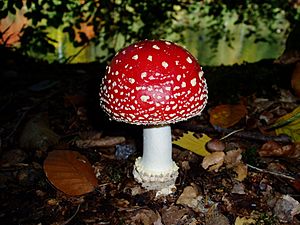
Some wild mushrooms are poisonous or hard to digest if eaten raw. It's very important to be absolutely sure about a mushroom's identity before you eat it. Mixing up a poisonous mushroom with an edible one can be very dangerous and has even caused deaths.
For example, the safety of eating Reishi mushrooms (also known as Lingzhi) has not been fully proven by science. Some people might have side effects like a dry mouth, itchiness, rash, upset stomach, or diarrhea from them. Always be careful and only eat mushrooms that you know are safe!
Images for kids
-
Chanterelles growing in the wild
-
Baskets of mixed culinary mushrooms at the San Francisco Ferry Building
-
Black Périgord truffle, cut in half
-
Stuffed mushrooms made with portobello mushrooms
-
Chicken of the woods (Laetiporus sulphureus)
-
Common Morel (Morchella esculenta)
See also
 In Spanish: Seta comestible para niños
In Spanish: Seta comestible para niños


